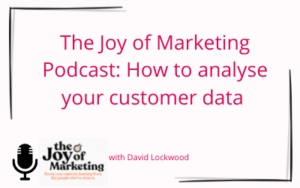Shortly before the close of 2020, 35 multi-channel retail leaders joined us in a lively discussion on the highs and lows of an extraordinary year in retail. We also welcomed our friends and channel experts Elliott Clayton from Conversant EU, Luke Jonas from Nest Performance and Matt Booker from Cousin Print Management to give their expert view. Here’s a round-up of the highlights.
2020: a retail review
Despite the unprecedented peaks and troughs across all retail channels this year, it’s been interesting to see overall sales bounce back in a V-shaped-curve after an initial dip in April 2020. In fact, according to the latest IMRG figures, UK online retail sales in October 2020 reported a 35.7% year-on-year increase.
Many retail sectors benefited from the increase. However gifting brands, perhaps due in part to a very successful Black Friday, reported a staggering 103% year-on-year uplift. Given the impact of several lockdowns this year, one of the figures we’ve kept our eye on is ‘online sales as a percentage of total retail sales’. This reached a record high of 36% in November.
Whether directly, or within wholesale environments, retailers have faced a number of challenges in 2020. In terms of fulfilment, they had to ensure they had enough warehouse space to enable social distancing, and enough staff to cope with demand. When it came to delivery, many needed to adapt their messaging in response to overstretched carrier networks – coupled with border delays. Live events suddenly became impossible, resulting in a necessary transition to remote trade shows, photoshoots etc. And unpredictable stock levels meant many retailers needed to quickly adjust strategy to help manage demand.
So, with multi-channel retail evolving more than we could have imagined this year, how have brands adapted their marketing plans to overcome these challenges, and keep their customers on-side?
Greater flexibility between channels
The most successful brands this year were those who were agile in their use of marketing channels – and in some cases – brave enough to shut off channels entirely for a short period of time to manage demand.
Media costs fluctuated more than usual, generally swinging in favour of buyers. And traditional media, such as cold mail, inserts, and TV, worked really well alongside digital channels this year. In fact, catalogue mailings had some of the best response that retailers have seen in years, and response stayed high for most throughout 2020. Many brands pulled their catalogues at the start of the first lockdown, fearing that customers wouldn’t buy. But those who kept focused and continued with their plans were rewarded. Jicmail reports that while Direct Mail and Door Drop volumes declined during Q2, more time spent at home saw double-digit increases in consumers interaction with and sharing of mail.
Combatting the cookie issue
Throughout 2020, the use of third-party cookies to target digital marketing has become increasingly limited. A challenge for retailers has been to source new ways to reach and engage audiences online – and using first-party cookies has been part of the answer. Asking site visitors for consent to use cookies and informing customers why and how their data is used, saw higher levels of engagement for retailers. This in turn enriched their customer dataset. In addition, marketing personalisation agencies helped retailers stitch together a range of disparate customer touchpoints to form a single customer view online. In this way, brands were able to better tailor their message to each customer segment through a variety of different online channels.
A wider scope for loyalty
Many multi-channel retailers reported the emergence of a group of new online customers in 2020. Large numbers of them ordered through the website for the first time during the first lockdown and stayed loyal to the channel, even after the shops reopened. To retain these new customers in 2021, brands have explored several approaches to loyalty. Tactics have ranged from traditional monetary reward schemes, for instance “earn £1 for every £10 spent”, to more light-touch loyalty programmes that encourage customers to interact with both the brand and its community. Points-based or interaction-led incentives have been described as a “much softer transactional language than money”, especially for retail brands in the gifting sector.
Meanwhile, a clothing retailer significantly increased engagement by implementing a dedicated customer advocacy platform. This encourages fans to upload real-life photos of themselves modelling the products, complete activity downloads with their families, and use certain hashtags on social media. As a result, website traffic soared. Despite being a marketing initiative designed to turn customers into brand ambassadors without incentivising a purchase, the platform led to a marked increase in average order value and frequency among those customers.
Other tactics included offering free, unlimited or discounted delivery subscriptions to selected customers. This also resulted in more frequent ordering over the course of the year. So, although the UK has some catching up to do in terms of the number of loyalty programmes brands have to offer, this is definitely becoming a more important part of the marketing strategy as we head into 2021.
Shining a spotlight on social
Continuing the theme of engagement breeding loyalty, social platforms have also become a mainstay of marketing in recent years. 2020 was no different. While Facebook and Instagram accounted for the lion’s share of social marketing, retail brands started to experiment with emerging channels such as Snapchat, TikTok and Pinterest.
Facebook CPMs dramatically decreased in 2020 compared with 2019. Curiously in February and March, just as Facebook reported record levels of traffic due to more individuals working from home, several large brands decided to pull back their advertising spend, which resulted in a sudden price drop of 30%. These factors created the perfect opportunity for some of the nimbler multi-channel retailers to take advantage of the situation and achieve some really impressive results in 2020.
As this memorable year draws to a close, we take with us a wealth of learnings. As clichéd as it sounds, the greater the hurdles retailers have faced throughout the pandemic, the stronger they will be as they enter into 2021. With new-found audiences, a solid path for retention, and a healthy mix of media through which to engage, the future of multi-channel retail is bright.




